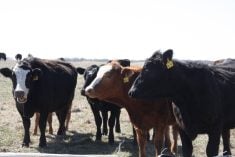This cattle market information is selected from the weekly report from Canfax, a division of the Canadian Cattle Association. More market information, analysis and statistics are available by becoming a Canfax subscriber by calling 403-275-5110 or at www.canfax.ca.
Fed prices struggle
As the year winds down, excitement usually builds around the fed market as prices strengthen and cattle feeders gain leverage over the packing sector. This has not been the case as fed prices have struggled in recent weeks, trading at the lowest point since April.
Read Also

Container dispute embroils Port of Vancouver
GCT wants to expand its existing container terminal at the Port of Vancouver, but it is running into opposition from the port itself.
From a supply perspective, fed calf numbers have started to decline, while yearling numbers have increased at a faster pace due to dry conditions.
Fed prices have set second half of the year lows in November only three times (1991, 2001, 2007) in the past 50 years.
Competition on the cash market was limited and sale volumes were too light to establish a weighted average price, but the market tone was steady to weaker. Dressed sales and bids were reported from $378-$383 per hundredweight delivered.
Last week’s Alberta fed cash-to-futures basis was estimated around -$4.50 per cwt. Historically, the Alberta fed basis strengthens from November to December. In Ontario, dressed bids/sales were reported from $388-$395 per cwt. delivered, steady with the previous week.
Fewer heifers are entering the slaughter mix in Eastern Canada, with year to date eastern Canadian heifer slaughter the smallest in over 10 years.
Feedlot margins have been positive for the past seven to eight months. If fed prices do not strengthen, margins will be negative for all classes of cattle in December.
In the U.S., dressed sales in Iowa and Nebraska ranged from US$273-$275 per cwt., steady to $5 per cwt. lower than the previous week. Live sales in all four major feeding states were from $174-$175 per cwt., $1-$3 per cwt. weaker.
U.S. steer carcass weights increased five pounds to average 936 lb., and are now the heaviest on record. U.S. beef cow slaughter for the week ending Nov. 18 totaled just over 83,000 head, one percent larger than last year. Over the past decade, this stands as the third largest beef cow slaughter volume.
Steady cow trade
Non-fed offerings tightened last week and slaughter cow prices traded mixed. D2 cows traded steady, averaging $122.29, while D3 prices slipped almost $3.50 per cwt. lower, to average $106.79.
Rail cow bids trended sideways for a second week from $245-$255 per cwt. delivered with a firmer price tone reported by weeks end. Butcher bull prices rebounded $2 higher than the previous week, averaging $146.61 per cwt.
Western Canadian non-fed slaughter for the week ending Nov. 25 surged 18 percent larger than the previous week to 11,171 head, the largest since February 2019. Year to date volume was 11 percent larger at 353,879 head.
Non-fed auction volumes are tightening, but a large inventory of captive slaughter cows are on feed to harvest in the New Year.
Feeder market softens
Volatile cattle futures and reduced hedging opportunities contributed to a softer feeder market last week. Calf prices traded mixed with steers steady to $2 per cwt. higher, while heifer calves traded $2-$6 per cwt. lower. Middle weight feeders from 600-800 lb. saw prices steady to $1 per cwt. lower.
Good demand continues for large feeders over 800 lb., but reduced quality and lot size pressured prices $1-$3 per cwt. lower. Calf and feeder prices were comparable across the Prairies as auction volumes tightened.
Alberta sale volumes were 19 percent smaller than the previous week at 33,811 head and were down 20 percent from the same week last year. Year to date auction volumes were 10 percent larger than year ago totaling 1,744,215 head and were 14 percent ahead of the five year historic average
Canadian feeder exports to the U.S. for the week ending Nov. 18 firmed 20 percent larger than the previous week to 4,972 head, and were 55 percent larger than the same week last year. Year to date feeder exports were down 13 percent from year ago, totaling 161,021 head.
Auction offerings will continue to tighten through December and increased tax buying should firm calf prices moving forward.
Choice cutout steadies
In U.S. beef trade, cutouts moved in opposite directions over the last couple of weeks. Choice cutouts are showing signs of life after being pressured mid-month, pushing upwards toward US$300 per cwt. and closing last week at $299.02. Select cutouts continued to slip, softening almost $6 per cwt. to close the week at $264.75.














